by Pamela Bartolo, of Pamela B. Levitt Art Advisory
I was very excited to attend Frieze LA for the first time in February. I’ve been lucky enough to have attended Frieze New York and Frieze London for several years, and LA’s second Frieze edition was just as insightful and rewarding. Launched in 2019, Frieze LA celebrated its sold-out second edition last month, shining a spotlight on LA’s artistic communities, and bringing together over 75 local and international galleries, as well as artists, institutions and collectors. The 2020 edition attracted over 35,000 visitors during its 4 days at Paramount Pictures Studios.
Within the gallery tent, world-renowned art-houses such as Gagosian, Pace, Hauser & Wirth, David Zwirner, Blum & Poe and Spruth Magers all had booths, as well as local galleries like The Box, Kayne Griffin Corcoran and David Kordansky Gallery (to name a few). Of the many incredible artists presented at Frieze, the below captures just a handful of the key stand-outs.
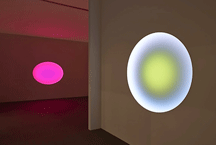
West-coast based, James Turrell’s LED installations (right), co-presented by Pace Gallery and Kayne Griffin Corcoran, seduce you in their immersive light and bright colours. As Turrell notes, “I want the light itself to be the revelation.” Associated with the Light and Space movement of the 1960s, Turrell investigates ‘perceptual art’, exploring the materiality of light and sensation, and interrogates the connection between constructed light and painting with light.
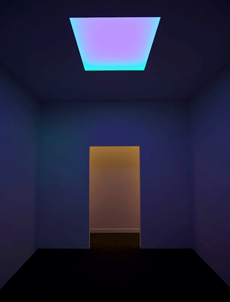
Also showcased was Turrell’s first ceiling-mounted artwork (right), part of his Glass series, which progresses through a two-and-a-half hour colour sequence, creating a riveting and hypnotic narrative of light and colour. Turrell builds on the emotional experience of space, colour and perception. The installation also sought to raise awareness of his Roden Crater – an open-air observatory built inside a collapsed volcano in the Arizona desert.
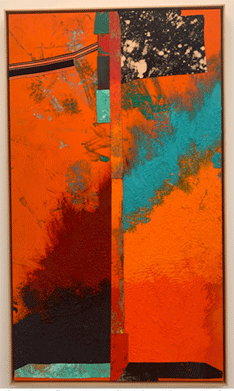
An incredibly striking artwork, (and one of my favourites) is Sterling Ruby’s WIDW.TERROR TEARS (2020), (left) presented by Brussels-based gallery Xavier Hufkens, which sold early-on for $350,000. Ruby, who lives and works in LA, is known for his material experimentation, and his WIDW (window) series (2016-) is no exception. His use of cheap recycled scraps, as well as polished materials, highlights his perception around archeology in the production of art, in that all materials existed previously, were laid to rest, and through the creation of art, were dug up and brought back to life. In WIDW.TERROR TEARS (2020), Ruby utilizes a collage of materials, including cardboard, elastic and fabric. His intense use of colour, the burnt orange, deep reds and blacks, with the visceral and dynamic and also unsettling display, reflect the artist’s exploration of cultural issues of violence and discrimination.
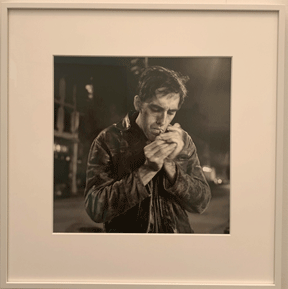
At the Maureen Paley booth (and the esteemed Maureen Paley herself was in attendance) was Peter Hujar’s David Lighting Up, Manhattan-Night (I) (1985), printed posthumously in 2018 (right). Hujar, known for his poignant and sensitive portraits, met David Wojnarowickz in NYC in 1980. Hujar frequently photographed his close friends, often in black and white, and usually in intimate and vulnerable settings. One can get lost in his portraits. They are lovingly piercing and penetrative, yet sensitive and imbued with a quiet and permeating haunting and melancholic essence. Wojnarowickz, also an artist, worked in multiple mediums, including painting, photography, film, and sculpture, and was a poet and writer. After Hujar’s death in 1987 of AIDS related pneumonia, David became an AIDS activist. His work unapologetically and loudly confronted the AIDS crisis and persecution of sexual minorities in Ronald Reagan’s America. Hujar’s death greatly impacted Wojnarowickz, and he later said “Everything I made…I made for Peter.” David died from complications related to AIDS in 1992, at the age of 37.
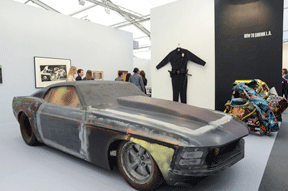
One couldn’t miss (even if one wanted to!) Richard Prince’s all-American, macho and aggressive, souped-up muscle car, the Ford Mustang, presented by Gagosian with a price tag of $5 million (right). Considered both a sculpture and a painting, Untitled (2008) reflects the artist’s incessant fascination with American subcultures and its reverence of celebrities, fast cars, bikes and cowboys. Prince also interrogates the dialectic around notions of authenticity, authorship and ownership, especially with his appropriation of images from mass media and advertising.
New for 2020, Frieze presented its “Focus LA” section, promoting local artists and providing a stage for emerging LA art spaces that have been open for 15 years or less. Highlights included hyperreal paintings by Sayre Gomez (fig.6), and Gladys Nilsson’s artworks investigating themes of sexuality and gender (fig.7).
And finally, providing a welcome reprieve from the intensity of the gallery tent, the Artist Street Fair, presented on Paramount’s iconic New York City backlot set, showcased many of LA’s creative enterprises and art-driven organizations, including the Women’s Center for Creative Work (WCCW), Artists for Democracy and Arts for LA. The backlot also hosted multiple pop-ups, including Roberta’s pizza and multiple Ruinart champagne stands.
